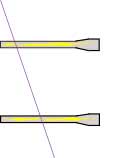![]()

![]()
Primary cosmic rays are mostly high kinetic energy protons. Some relatively low energy cosmic rays are generated by the Sun. But much higher energy cosmic rays with typical energies of several billion electron volts (GeV = 109 eV), and occasionally as much as a trillion electron volts (TeV = 1012 eV) are believed to originate much further away. When the primary cosmic rays collide with nuclei of air molecules in the Earth's upper atmosphere they create a shower of elementary particles including many pions (π) which quickly decay. The extent of the shower depends on the energy of the primary cosmic ray. Each charged pion decays to a pair or neutrinos and a muon (μ). Muons don't react with atoms. While they have a short half life (2 x 10-6 s), their mass (106 MeV ≈ 200 times that of an electron) and high speed near that of the speed of light, allows a portion of them to reach the surface of the earth. Since they are not absorbed by atoms, they penetrate buildings and pass through our bodies, brains and sense organs, without interaction that might cause detection. However when the negatively charged muons pass near negatively charged electrons both are deflected. The much larger deflections of the much less massive electrons generate light in certain materials which can be detected.
Little is known about the most energetic cosmic rays. Because of their high energies, their showers might extend over areas larger than cities. So collaborative efforts recording precise detection times and locations might significantly contribute to the understanding of cosmic rays.
 The Stanford Linear Accelerator Center (SLAC) maintains a set of cosmic ray detectors at their visitor center which can be viewed on the Web. (At night the lights are off so the Web camera only shows the apparatus during daylight. But the detectors have a black covering to exclude extraneous visible light so the detectors operate 24/7.) Several pairs of detectors are wired to roughly detect direction by only counting a cosmic ray if it is detected by both detectors. Take the sequential Tours Stops available using the data center and use current data to do the investigations described.
The Stanford Linear Accelerator Center (SLAC) maintains a set of cosmic ray detectors at their visitor center which can be viewed on the Web. (At night the lights are off so the Web camera only shows the apparatus during daylight. But the detectors have a black covering to exclude extraneous visible light so the detectors operate 24/7.) Several pairs of detectors are wired to roughly detect direction by only counting a cosmic ray if it is detected by both detectors. Take the sequential Tours Stops available using the data center and use current data to do the investigations described.
To study cosmic rays, a collaboration of high school students and teachers has been formed, coordinated by scientists at a number of U.S. national laboratories and research centers, administered by FermiLab. You may log into their web-based QuarkNet collaboration as a guest. You can currently access and analyze data gathered by the collaboration. Eventually the QuarkNet project may provide access for supercomputer analysis of the data. Other experiments are also being planned The overview of QuarkNet can be accessed at the QuarkNet Index page.
 A group of physics teachers (including the author) worked at SLAC to assemble cosmic ray detectors to be loaned to schools for student use. One is shown at right being cleaned before receiving its light blocking covering. Detail description of that process is available accompanied by many photographs.
A group of physics teachers (including the author) worked at SLAC to assemble cosmic ray detectors to be loaned to schools for student use. One is shown at right being cleaned before receiving its light blocking covering. Detail description of that process is available accompanied by many photographs.
Communicating technical information such as observations and findings is a skill used by scientists but useful for most others. If you need course credit, use your observations in your journal to construct a formal report.
![]()
to Lab III-1 (next experiment)
to e-Physics menu
to site menu